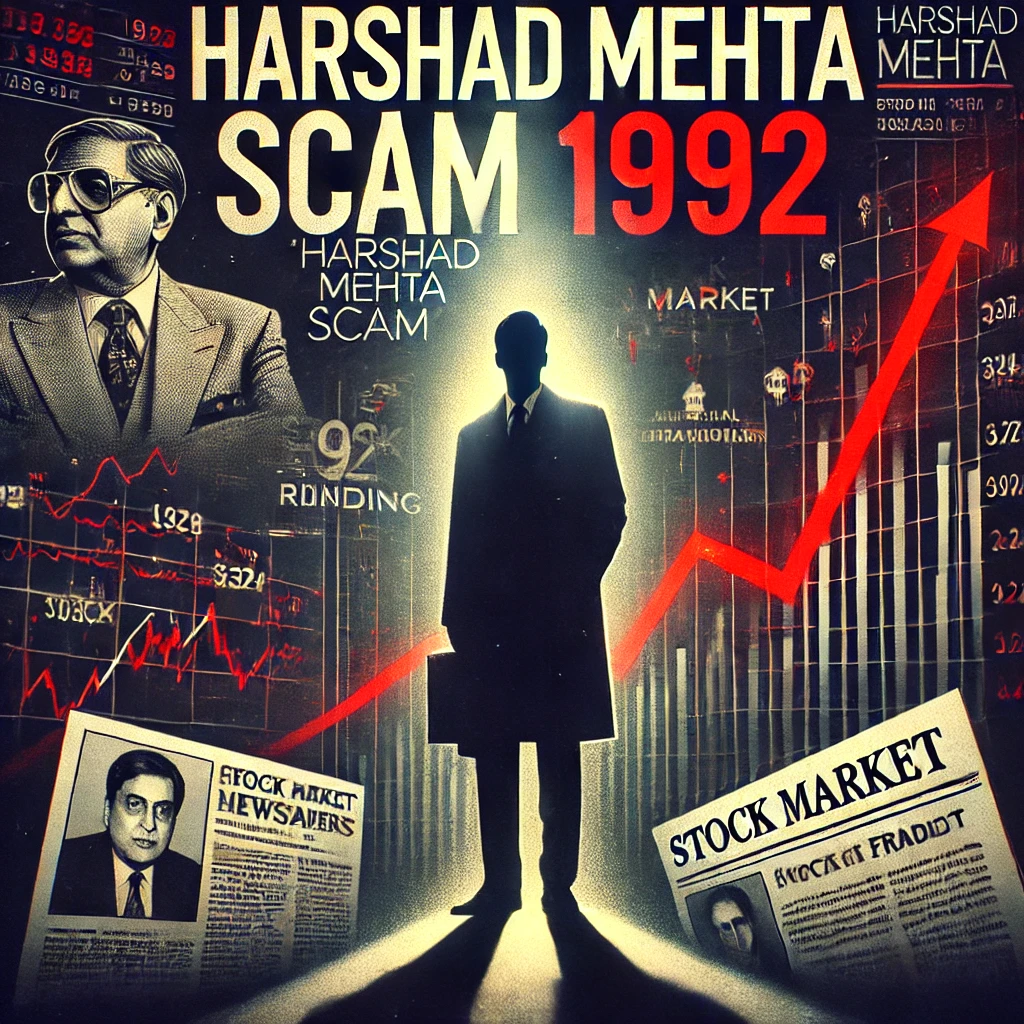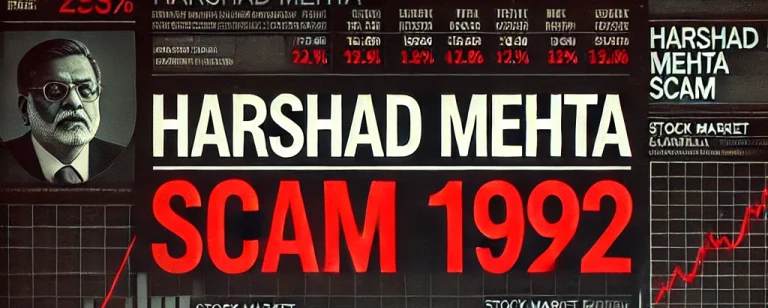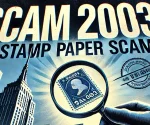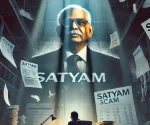The Harshad Mehta scam is one of the largest financial frauds India has ever witnessed. It was in 1992 when this happened, involving manipulation of the stock market. This resulted in banks and investors losing a huge sum of ₹4,000 crores (about $1 billion). People knew the man behind this scam as the “Big Bull” of the Indian stock market. He had his charm and connections that let him execute this scam. It has long-term consequences in India’s financial system. Let’s get into the details of this shocking scam.
Who Was Harshad Mehta?
Harshad Mehta was born on July 29, 1954, in Mumbai. He came from a middle-class family and had a humble start in life. Mehta studied commerce and worked in different jobs before becoming a salesperson in a brokerage firm. His sharp mind and interest in the stock market helped him start his firm, Grow More Research and Asset Management.
In the late 1980s and early 1990s, Mehta became famous for making bold stock market moves. People began calling him the “Big Bull” because of his ability to predict stock market trends and make huge profits. However, he built his success on unethical practices and fraud.
Background of Harshad Mehta
People often refer to Harshad Mehta’s life as a rags-to-riches story that went wrong. He was born into a lower-middle-class Gujarati family. Mehta moved to Mumbai (then Bombay) in the 1970s, hoping to make his fortune.
At first, Mehta did odd jobs. He sold hosiery and cement. But he had bigger dreams. He became interested in the stock market and wanted to be a part of it. Soon, he started working as a jobber (a type of broker) at the Bombay Stock Exchange (BSE).
Mehta was a fast learner. He understood the stock market quickly. By the 1980s, he had set up his firm called GrowMore Research and Asset Management. His rise in the stock market was very fast. People began calling him the “Big Bull” of Dalal Street because of his bold and aggressive trading style.
What made Mehta special was his ability to find undervalued stocks. He could persuade others to invest in those stocks by showing them the potential he saw. One of his famous ideas was the “replacement cost theory.” This theory states that investors should value stocks based on the cost of building a similar business from scratch.
As Mehta became more successful, his lifestyle changed. He bought luxury cars and lived in a big 15,000 sq ft apartment in Worli, a rich area of Mumbai. He wore designer suits and hosted lavish parties. His lifestyle became the talk of the town.
But behind all this wealth and glamour, Mehta was doing something risky. He used his connections in banks and financial institutions to get money illegally. He manipulated stock prices to make a profit. This dangerous game would eventually lead to his downfall.

How Did the Scam Work?
The Harshad Mehta scam involved several illegal activities. These practices allowed Mehta to manipulate stock prices and make large profits. Here’s how he did it:
1. Ready Forward Deals
At the time, banks had to keep a portion of their deposits in government securities. To get quick funds, banks used a system called “Ready Forward Deals.” In these deals, banks exchanged securities for cash. Mehta took advantage of this system by issuing cheques in his name instead of the bank. He would then approach another bank to get more money for the same securities. This allowed him to get a huge amount of money from banks.
2. Fake Bank Receipts (BRs)
Harshad Mehta used fake Bank Receipts (BRs) to raise huge amounts of money. A Bank Receipt is a document that acknowledges the receipt of funds in exchange for selling securities. Mehta convinced banks to issue fake BRs, which allowed him to get loans without having any real securities to back them. He then used this borrowed money to buy large quantities of stocks, pushing their prices up.
3. Circular Trading
Traders buy and sell stocks between each other to create the illusion of high demand in circular trading. Mehta used this tactic to inflate the prices of stocks. By doing this, he attracted other investors who thought the stocks were doing well, leading to even higher prices.
4. Spreading False Information
Mehta also spread false information to hype up certain stocks. This created excitement in the market, and many investors bought those stocks, driving their prices even higher. But in reality, these stocks had no real value.
Read about the Scam of 2003: Abdul Karim.
Key Stocks Targeted by Mehta
Harshad Mehta’s manipulation targeted several key stocks. He manipulated some of the stocks below:
- ACC (Associated Cement Companies): Mehta increased the price of ACC stock from ₹200 to over ₹9,000 in just a few months. Buying large amounts of shares and using circular trading created an illusion of demand.
- Sterlite Industries: Mehta inflated the price of Sterlite stock from ₹30 to ₹1,500. Again, he used money borrowed from banks and circular trading to push the price up.
- Videocon: Mehta manipulated Videocon’s stock, causing its price to jump from ₹45 to ₹2,000. The artificial demand caused many investors to buy the stock, only to lose money when the bubble burst.
Key Figures Involved in the Scam
Several people either participated in the scam or played a role in exposing it. Let’s take a look at the key figures:
1. Harshad Mehta: Harshad Mehta was the mastermind of the scam. His innovative thinking helped him manipulate the stock market. He used loopholes in the banking and stock market systems to carry out his illegal activities.
2. S. Venkitaramanan: S. Venkitaramanan was the Governor of the Reserve Bank of India (RBI) at the time of the scam. The RBI failed to detect the fraud before it happened. After exposing the scam, he played an important role in introducing reforms to prevent such scams in the future.
3. Sucheta Dalal: Sucheta Dalal was a journalist with the Times of India. She helped uncover the scam by exposing the connection between Harshad Mehta’s lavish lifestyle and the rising stock prices. Her work forced the authorities to investigate the fraud.
4. P. V. Narasimha Rao: P. V. Narasimha Rao was the Prime Minister of India during the scam. Though there was no evidence, some accused him of accepting bribes from Harshad Mehta to protect him from legal action. This added a political angle to the scam.

Impact of the Harshad Mehta Scam
The Harshad Mehta scam had a huge impact on the Indian stock market and the economy. Here’s how it affected different sectors:
1. Stock Market Crash
When the scam was exposed in April 1992, the Indian stock market went into a freefall. Investors panicked and started selling their stocks. As a result, the Bombay Stock Exchange (BSE) lost nearly half of its value. This led to a loss of billions of rupees for investors.
2. Regulatory Reforms
The scam exposed the weaknesses in the Indian financial system. As a result, the government had to introduce strict regulatory reforms. The Securities and Exchange Board of India (SEBI) was given more powers to regulate the stock market. New rules also introduced for IPOs (Initial Public Offerings) and stock trading practices.
3. Loss of Investor Confidence
The scam severely damaged investor confidence in the Indian financial system. Many people who had invested their life savings in the stock market lost huge amounts of money. This created a negative sentiment towards the stock market, and it took years to rebuild trust among investors.
4. Economic Aftermath
The scam did not limit its effects to the stock market. The banking sector also suffered huge losses, which led to tighter credit conditions. This caused a slowdown in economic growth. Financial institutions had to undergo major reforms to strengthen accountability and governance.
Public and Media Reaction
The Harshad Mehta scam captured the public imagination like few financial scandals before or since. The public and media had strong reactions to the scam. Let’s look at how they responded:
1. Media Coverage
The scam received massive media coverage. Newspapers and TV channels extensively reported on the details of the scam. The media played an important role in educating the public about the fraudulent activities and the people involved.
2. Public Outcry
The public expressed shock and anger. Many investors felt betrayed, and there were protests demanding accountability. People wanted the government to take action and punish those responsible for the scam.
3. Cultural Representations
The Harshad Mehta scam has inspired several films, documentaries, and even a popular web series called Scam 1992. The series, based on the book The Scam by Sucheta Dalal and Debashish Basu, brought the story of Harshad Mehta to a new generation. The scam remains a symbol of financial corruption and deception.
Conclusion
The Harshad Mehta scam was a turning point in India’s financial history. It exposed the loopholes in the stock market and banking systems. Regulatory reforms resulting from the aftermath changed the way regulators governed the stock market. Harshad Mehta’s rise and fall serve as a cautionary tale of how greed and manipulation can lead to disastrous consequences. The scam is a reminder of the importance of transparency, accountability, and vigilance in the financial system.
Scam 1992 FAQs
How did Harshad Mehta carry out the scam?
Mehta used fake bank receipts to obtain funds from banks, which he then used to buy large quantities of stocks, driving up their prices. He also manipulated the ready-forward deal system between banks.
Are there any movies or shows about the Harshad Mehta scam?
Yes, the scam has been portrayed in various media. The most notable recent adaptation is the web series “Scam 1992: The Harshad Mehta Story”, which gained wide popularity and critical acclaim.
What was the Harshad Mehta scam 1992 story?
The 1992 Harshad Mehta scam was a massive financial fraud where Mehta exploited loopholes in the banking system to funnel money into the stock market, artificially inflating stock prices and causing a market crash when exposed.
How did Sucheta Dalal expose the scam?
Sucheta Dalal, a journalist with The Times of India, exposed the scam by revealing the fraudulent use of bank receipts to manipulate stock prices.


